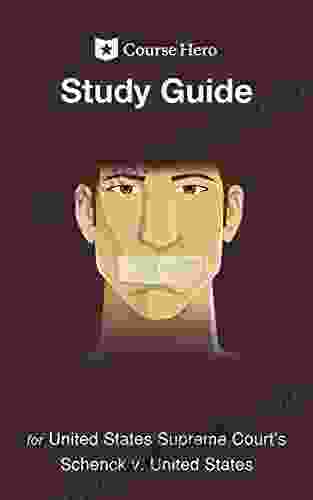Study Guide for United States Supreme Court Case: Schenck v. United States—Understanding the Limits of Free Speech

The United States Supreme Court case of Schenck v. United States (1919) holds a significant place in the history of free speech jurisprudence. The case challenged the limits of free speech during wartime and established the "clear and present danger" test, a framework for determining whether speech may be lawfully restricted. This article provides a comprehensive study guide for Schenck v. United States, exploring its historical context, the legal principles involved, and the case's lasting legacy.
Historical Context
The United States entered World War I in 1917. The government, seeking to mobilize public support for the war effort, enacted the Espionage Act of 1917. This act prohibited any speech that would obstruct the recruiting or enlistment of soldiers or promote insubordination within the armed forces.
4 out of 5
| Language | : | English |
| File size | : | 640 KB |
| Screen Reader | : | Supported |
| Print length | : | 146 pages |
| Lending | : | Enabled |
| Paperback | : | 106 pages |
| Item Weight | : | 5.9 ounces |
| Dimensions | : | 6 x 0.27 x 9 inches |
In 1918, Charles Schenck, the secretary of the Socialist Party of America, was arrested for distributing leaflets opposing the draft. The leaflets claimed that the draft violated the Thirteenth Amendment, which prohibited slavery and involuntary servitude.
Legal Principles
The central legal issue in Schenck v. United States was the extent to which the Espionage Act could restrict free speech. Justice Holmes, writing for the majority, introduced the "clear and present danger" test. This test states that speech may only be restricted if it poses "a clear and present danger" to the security of the nation.
In applying the test to Schenck's leaflets, Justice Holmes found that the leaflets did pose a clear and present danger to the war effort. He argued that the leaflets could incite resistance to the draft and undermine the morale of the troops.
Impact and Legacy
Schenck v. United States established a balance between the First Amendment right to free speech and the government's interest in protecting national security. The "clear and present danger" test remains a pivotal standard in free speech law, guiding the courts in determining when speech may be restricted.
The case has been used both to uphold and limit free speech in a variety of contexts. For example, it has been cited to justify restrictions on speech advocating for violence or overthrow of the government. However, it has also been used to protect speech critical of the government, such as political protests and whistleblower disclosures.
Study Guide Questions
- What were the historical circumstances surrounding Schenck v. United States?
- Explain the "clear and present danger" test and how it was applied in Schenck v. United States.
- Discuss the impact and legacy of Schenck v. United States on free speech jurisprudence.
- How has the "clear and present danger" test been used and challenged in subsequent cases?
- Consider the tension between national security and free speech. How does Schenck v. United States balance these interests?
- Research other Supreme Court cases that have addressed the limits of free speech. How do these cases compare to Schenck v. United States?
Additional Resources
- Schenck v. United States on Oyez
- Schenck v. United States on Wex Legal Dictionary
- Schenck v. United States on Free Speech Center
Schenck v. United States is a landmark Supreme Court case that continues to shape the debate over free speech in the United States. The "clear and present danger" test established in this case has become a crucial framework for balancing the First Amendment rights of individuals with the government's interest in protecting national security. Understanding Schenck v. United States is essential for anyone interested in the history of free speech, constitutional law, or the ongoing dialogue between security and liberty.
4 out of 5
| Language | : | English |
| File size | : | 640 KB |
| Screen Reader | : | Supported |
| Print length | : | 146 pages |
| Lending | : | Enabled |
| Paperback | : | 106 pages |
| Item Weight | : | 5.9 ounces |
| Dimensions | : | 6 x 0.27 x 9 inches |
Do you want to contribute by writing guest posts on this blog?
Please contact us and send us a resume of previous articles that you have written.
 Book
Book Novel
Novel Page
Page Chapter
Chapter Text
Text Story
Story Genre
Genre Reader
Reader Library
Library Paperback
Paperback E-book
E-book Magazine
Magazine Newspaper
Newspaper Paragraph
Paragraph Sentence
Sentence Bookmark
Bookmark Shelf
Shelf Glossary
Glossary Bibliography
Bibliography Foreword
Foreword Preface
Preface Synopsis
Synopsis Annotation
Annotation Footnote
Footnote Manuscript
Manuscript Scroll
Scroll Codex
Codex Tome
Tome Bestseller
Bestseller Classics
Classics Library card
Library card Narrative
Narrative Biography
Biography Autobiography
Autobiography Memoir
Memoir Reference
Reference Encyclopedia
Encyclopedia Tom Mcnichol
Tom Mcnichol Conor Kostick
Conor Kostick Cornelius Lanczos
Cornelius Lanczos Cody Alexander
Cody Alexander Michael J Bradley
Michael J Bradley Monica Whitlock
Monica Whitlock Tony Bodoh
Tony Bodoh Madeline Valentine
Madeline Valentine Syl Sobel
Syl Sobel Markus Belkin
Markus Belkin Vinita Ved
Vinita Ved Geoff Johns
Geoff Johns Cynthia Snyder Dionisio
Cynthia Snyder Dionisio Paul Ernest
Paul Ernest Sean Cooney
Sean Cooney Colin Shaw
Colin Shaw Geoff Rodkey
Geoff Rodkey Franco Figueroa
Franco Figueroa Chuck Wendig
Chuck Wendig Lucinde Hutzenlaub
Lucinde Hutzenlaub
Light bulbAdvertise smarter! Our strategic ad space ensures maximum exposure. Reserve your spot today!

 Samuel BeckettThe Strange Friendship Between Houdini and Conan Doyle: A Tale of Magic,...
Samuel BeckettThe Strange Friendship Between Houdini and Conan Doyle: A Tale of Magic,...
 Joseph FosterDiscover the Depths of the Earth with "Journey to the Center of the Earth":...
Joseph FosterDiscover the Depths of the Earth with "Journey to the Center of the Earth":...
 Herman MitchellUnravel the Enigmatic Hollow Kingdom: The Unforgettable Journey of Close Kin...
Herman MitchellUnravel the Enigmatic Hollow Kingdom: The Unforgettable Journey of Close Kin... Rick NelsonFollow ·7k
Rick NelsonFollow ·7k Manuel ButlerFollow ·13.2k
Manuel ButlerFollow ·13.2k George OrwellFollow ·4.4k
George OrwellFollow ·4.4k Rob FosterFollow ·18.4k
Rob FosterFollow ·18.4k John KeatsFollow ·10.7k
John KeatsFollow ·10.7k Richard WrightFollow ·16.3k
Richard WrightFollow ·16.3k Jermaine PowellFollow ·15.1k
Jermaine PowellFollow ·15.1k Neil GaimanFollow ·18.7k
Neil GaimanFollow ·18.7k

 Howard Blair
Howard BlairThe Bewitching of Camille: A Mystical Tapestry of...
Prepare to be...

 Kirk Hayes
Kirk HayesUnraveling the Enigmatic Tale of "Vanished But Still...
In the labyrinth of memory...

 Joe Simmons
Joe SimmonsDogwild: An Unforgettable Literary Odyssey into the Heart...
Delve into the Untamed...

 Edgar Allan Poe
Edgar Allan PoeIndulge in Culinary Delights: Your Ultimate Costa Brava...
Discover the Flavors of Spain's Coastal...
4 out of 5
| Language | : | English |
| File size | : | 640 KB |
| Screen Reader | : | Supported |
| Print length | : | 146 pages |
| Lending | : | Enabled |
| Paperback | : | 106 pages |
| Item Weight | : | 5.9 ounces |
| Dimensions | : | 6 x 0.27 x 9 inches |










